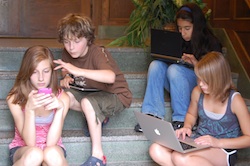Contributed by Lauren A. Curry.
Last Thanksgiving I struck up a conversation with a young man at a neighbor’s cocktail party. I had met him a few times over the summer while he worked taking care of the neighbors’ kids. I knew him as personable and funny, with a seemingly endless well of patience when it came to managing the munchkins (mine included).
I asked Ben how college was going, and he was eager to tell me about his classes and how he’d been selected to participate in a highly competitive study abroad program next year. It was easy to see that he is both enjoying and excelling in the college environment.
“Where did you grow up, Ben?” I asked. “Milton,” he replied, prompting my immediate next question: “when?”
It turns out Ben was a student at Milton Junior High School (now Milton Middle School) at the same time the Tarrant Foundation was piloting our very first technology integration program there. Ben wasn’t part of the main cohort of students involved, but a couple of his classes were in the pilot. In those classes, he’d gotten to experience first-hand what, at the time, was considered a risky new strategy.
While platters of tasty hors d’oeuvres circled the room, I got to listen to Ben talk about what a difference it had made for him and his peers to have access to technology throughout their learning day. He described feeling lucky, because technology made school more interesting for him. He used words like freedom and flexibility and creativity. And he talked about using the skills and thought processes developed back then in doing his college coursework now.
My kingdom for a tape recorder!
Er, digital recorder … but you get my point. The most powerful advocates for any intervention are those who experience it. While I’ve had the opportunity to meet and talk with scores of kids about their experiences at our partner schools as they go through them, this was the first time I ever spoke to a student after the fact—to someone who was looking back on how our work did (or didn’t) affect his path forward in life. It was powerful testimony.
One of our board members suggested we reach out to Ben and see if we could capture his story on video. Happily for us, he was excited by the prospect. And so on a snowy, gray day during his winter break, we met at RetroMotion Media and Ben told his story again, this time to cameras and a boom mic. You can watch it here.
When I watched Ben in the studio—and as I watch this video now—I think about that tiny first cohort of kids. I think, too, about the many that have followed in its footsteps. There’s no doubt that the scale of our impact and outreach now would have been difficult to imagine then. Hundreds of Vermont teachers draw on the Tarrant Institute for professional development, support and encouragement as they move forward in tech-integrated learning environments. Thousands of their students experience learning that is more personalized, more relevant, and more successful as a result.
For me, though, the moral of Ben’s story is that even if we had never gotten beyond our pilot phase … even if we had never touched more than that very first handful of kids, it still would have been worth it. It would have been worth every penny.
Lauren A. Curry has been the Executive Director of the Richard E. and Deborah L. Tarrant Foundation since 2005.



 @tarrantgiving
@tarrantgiving